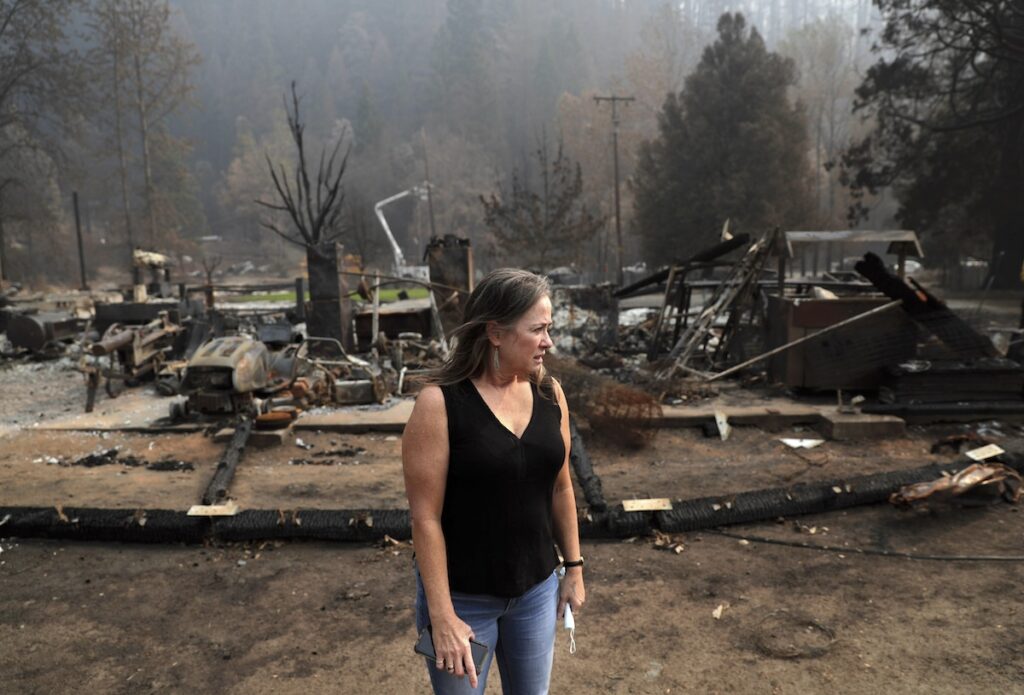California Wildfire Smoke Impacts Indigenous Communities Nearly 2x More Than Expected
4 min read
A member of the Karuk Tribe in Happy Camp, California surveys the damage to her home after the Slater Fire burned thousands of acres, on Sept. 30, 2020. A new study finds that California’s Indigenous communities are disproportionately impacted by wildfire smoke. Carlos Avila Gonzalez / The San Francisco Chronicle via Getty Images
Founded in 2005 as an Ohio-based environmental newspaper, EcoWatch is a digital platform dedicated to publishing quality, science-based content on environmental issues, causes, and solutions.
Indigenous communities in California are exposed to disproportionate levels of particulate matter in amounts much greater than previously thought, a new study has found.
Using a new technique of measuring prolonged exposure to wildfire smoke, the researchers discovered that the Indigenous communities were exposed to an average of roughly 1.7 times the smoke that would be expected, considering Indigenous populations statewide each year between 2006 and 2020, reported Berkeley News.
The scientists said their new exposure measurement matrix will assist with understanding the effects of long-term smoke exposure for epidemiological and environmental justice studies — essential for vulnerable communities.
“Analyses spanning 2006 to 2020 revealed that Native American and Alaska Native, multiracial, and non-Hispanic white populations had consistently disproportionate outdoor wildfire PM2.5 [fine particulate matter] exposure. Housing, occupational, behavioral, or economic constraints may result in larger actual disparities,” the researchers wrote in the study paper. “Improved long-term wildfire PM2.5 exposure measurement can support health-equity-focused interventions and climate resilience.”
Co-author of the paper Rachel Morello-Frosch, a UC Berkeley professor of public health and environmental science, policy and management, said the knowledge is becoming more and more important as millions across the United States are being exposed to toxic smoke from ever-increasing climate change-fueled wildfires.
“Now that wildfires are coming at us sequentially, and clearly are going to be increasing in frequency and intensity, we can’t look at them one at a time,” Morello-Frosch said, according to Berkeley News. “We have to look at them using a more cumulative exposure framework.”
The study, “Measuring long-term exposure to wildfire PM2.5 in California: Time-varying inequities in environmental burden,” was published in the journal Proceedings of the National Academy of Sciences.
The study of pollution coming from chimneys, tailpipes and power plants — particulate matter — has long been evaluated by monitors set up by the U.S. Environmental Protection Agency (EPA), but those measurements are usually averaged, Berkeley News reported. This leads to the effects of extreme events like wildfire smoke from one mega-fire that lasts just a few days being spread out over the entire year. This obscures severity, which could be the crucial factor in terms of health, particularly considering extremes are happening more often due to climate change. It also makes it harder to trace long-term health impacts caused by wildfire smoke.
To find out how extreme events fit into the wider health narrative, the researchers came up with five novel metrics to be used in tandem for an improved assessment of the intensity, duration and frequency of exposure to smoke.
Factors such as the most intense week of wildfire smoke exposure in a year or the amount of smoke waves in a particular area that last for two days in a row can assist scientists in pinpointing exposures that might have slipped under the radar.
“That may really matter for certain types of disease processes much more than the average smoothed out over the year,” said Joan Casey, lead author of the paper and a University of Washington assistant professor of environmental and occupational health sciences, as reported by Berkeley News.
A big problem with the EPA sensors is that they don’t specify where the particulate matter is coming from. To get around that in the study, co-author Tarik Benmarhnia — a UC San Diego Scripps Institution of Oceanography associate professor — looked at satellite images of smoke to find out when and where fires caused spikes of particulate matter.
“Developing such metrics to capture populations’ exposures to such repeated events can help provide a more nuanced and realistic picture of how novel environmental hazards can lead to inequities across various communities,” Benmarhnia said. “Focusing on wildfire smoke is particularly timely, as this has become the major source of air pollution in the past few years.”
The researchers said the study raised important environmental justice concerns and expressed hope that it would inspire new methods of quantifying people’s exposure to other threats like flooding.
“The beauty of this paper is that it provides a proof of concept about how we need to be looking at the effects of a wildfire on communities at a granular level,” said Morello-Frosch in Berkeley News. “It’s a really great foundation for how to assess exposures in this long-term framework in order to more accurately assess health effects of perennial fire events that are no longer restricted to the western part of the United States.”
Subscribe to get exclusive updates in our daily newsletter!
By signing up, you agree to the Terms of Use and Privacy Policy & to receive electronic communications from EcoWatch Media Group, which may include marketing promotions, advertisements and sponsored content.





